I spent some time that evening downloading the photos I'd taken thus far and just as I was done I looked out the window to be greeted by a gorgeous sunset.
Nothing like a windy day in the desert to stir up enough dust to make a good sunset.
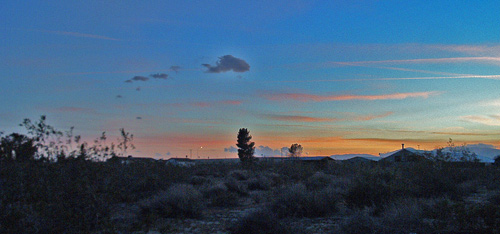
I had to trot out of the RV park and into an open field to get a clear view of the sky--but it was worth it.
The next morning the winds had died down and we had clear sailing for the drive out to Joshua Tree. We found a nice campsite at Jumbo Rocks campground.
Here's a view from the picnic table in our site.
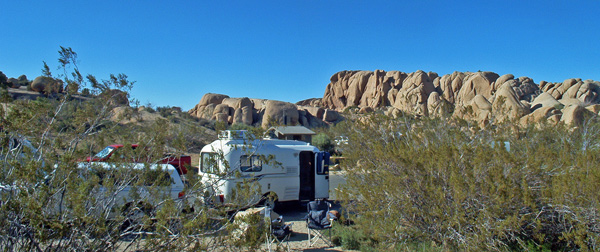
This part of Joshua Tree National Park is at 4,000 ft elevation. The park is very primitive from a services point of view. There's no water or power in the interior. There are three sources of water--we're talking one water spigot at each location--at three spots around the edge of the park, two in the north and one in the south. And miles and miles of open desert ranging from 2,000 to 4,000 feet.
It was clear, sunny and in the low 70's at Jumbo Rocks. Driving in from the north there were huge swathes of yellow flowers that are called desert dandelion.
We spent two days driving the roads and hiking the trails and taking tons of wildflower pictures.
The Joshua Trees--for which the park is named--were in bloom and there are some incredible specimens all over the upper elevations of the park.
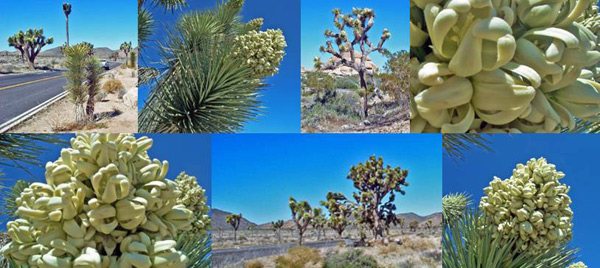
Juvenile Joshua Trees are just straight little columns of spines (see upper left corner). They continue growing straight up until the flower for the first time. Each time they flower, they branch out. Some of the trees pictured here are hundreds of years old.
Driving south we came to an area called the cholla garden. It was a wonderful expanse of cholla (pronounced choya) cactus--acres of them with a trail winding through them.
I'd never seen them in bloom before. Don't be fooled; they may be called teddy bear cholla because they look fuzzy. They're not!
Just south of the cholla garden we came to a big stand of Ocotillo in bloom.
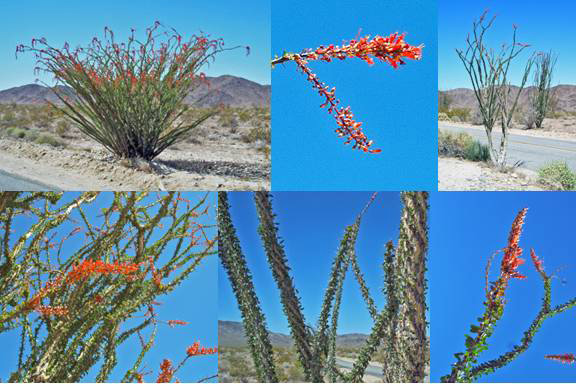
During the dry season Ocotillo just look like a cluster of grey dead sticks. About 3 weeks after it rains, they put out leaves all over their stems and if you're really lucky they sprout red flowers too. The big one in the upper left-hand corner was about 20 feet tall.
At Cottonwood Visitor Center we stopped to fill up our water jugs, get a flower id pamphlet (gotta know their names!) and take a hike. There's an oasis there with California Fan Palms.
On the ground by the bushes where Walter is standing there was a little seep of water. A whole bunch of butterflies (what is a group of butterflies called? A flutter?) were gathered there.
You had to be very still so they'd settle down and stay still for a picture.
From the oasis we took a hike down a wash where there were lots of wildflowers and cactus in bloom.
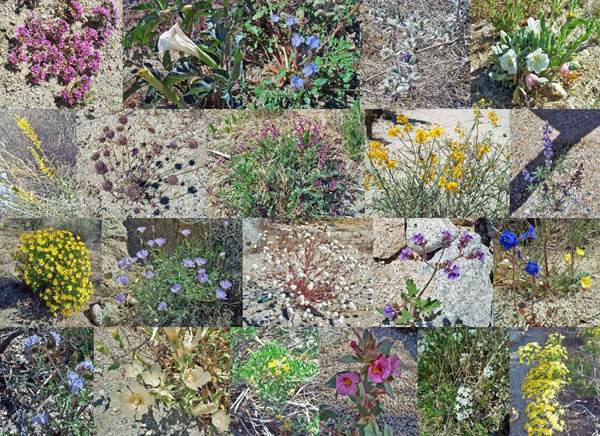
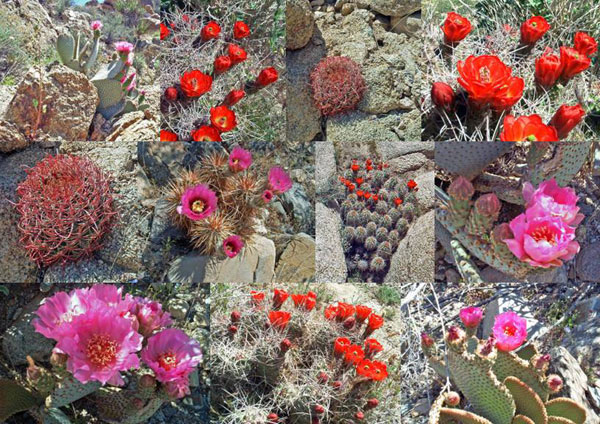
We didn't see all of these on that one hike but I'd say over half of these two sets of photos were taken that first day and the rest the second.
Late in the afternoon we took a hike from our campsite out to a feature called Skull Rock.
There were more flowers and several nice panoramas that I captured.
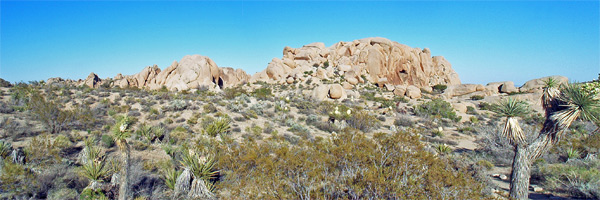

You can tell why this is a major rock climbing Mecca!
Along the trail we came across this big desert juniper.
He's an OLD guy.
The next day was warmer so we stayed at the higher elevations of the park to get away from the 90+ weather further down. There were lots of folks up from Palm Springs and other places in the desert trying to cool off.
We drove out to Keys View where you can see all the way to Salton Sea on a clear day.
If you use your imagination, it's that little bit of blue between the brown ridge and the blue/grey mountains.
In this panorama shot you can just see the snow on the mountains on the right.

From Keys View we went out to the trail that leads to Barker Dam. In the early 1900's folks attempted to ranch and mine in this area and there are bits and pieces of their buildings still around. This trail was a very nice hike through the rocks with lots of flowers.
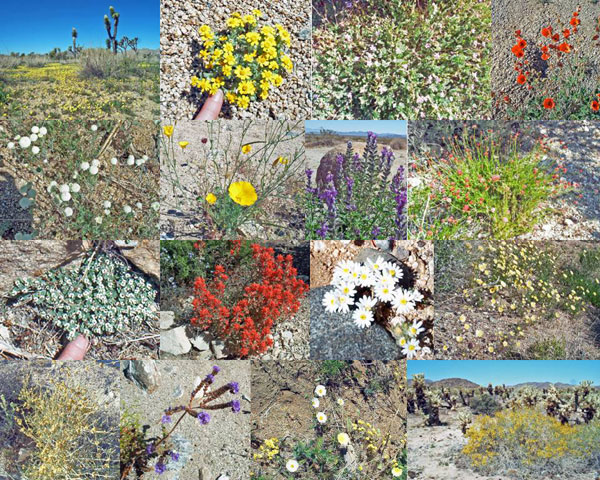
Desert wild flowers comes in all sizes from little tiny things like the ones above where I've shown my index finger to give you a sense of scale to the huge cactus and yucca flowers.
The Mojave Yuccas were in bloom all over the park. Yuccas and Joshua Trees are in the same family. The yuccas are shorter and much more orderly but less fanciful in my mind.
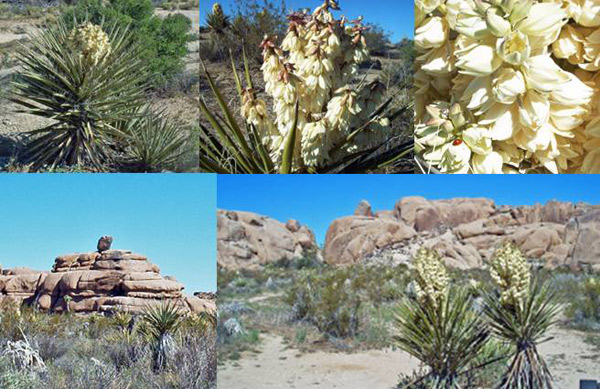
The flower buds are maroon before they swell and open. Do you see the lady bug on flowers at upper right?
Wouldn't you think that all those flowers and yuccas would be enough of a reward for taking a hike? Well this one had an addition bonus. Barker Dam creates a little oasis out in the middle of the desert.
There were kids and adults scrambling all over the rocks here and many mothers working very hard to keep their kids out of the water! They say that at some times of the year there are also lots of birds here but we didn't see very many.
The dam has begun to leak lowering the level of the pond and feeding a stream that wanders off into the desert.
I caught this really fun picture at the dam's edge.
Joshua Tree is a great place.
During the week we had it mostly to ourselves. Come Thursday afternoon the campgrounds begin to fill up and by Friday noon they were all full.
On Saturday there were climbers everywhere and all the parking lots were nearly full of day-trippers and hikers. Come Sunday morning, everyone packed up and left and by 10 am the campground was empty again.
We'd gone quite a few days without showers and the forecast was for a really hot day so we took off and went into the town of Twenty Nine Palms to an RV park that had showers and electricity so we could hook up the trailer and run the air conditioning. It was in the nineties and we holed up in the trailer all day reading the paper and surfing the web. It's the first time we've ever run the air conditioning for that long!
From here we're going to head south to the beach at Carlsbad and the San Diego. Go to Part 3 to read about that.
